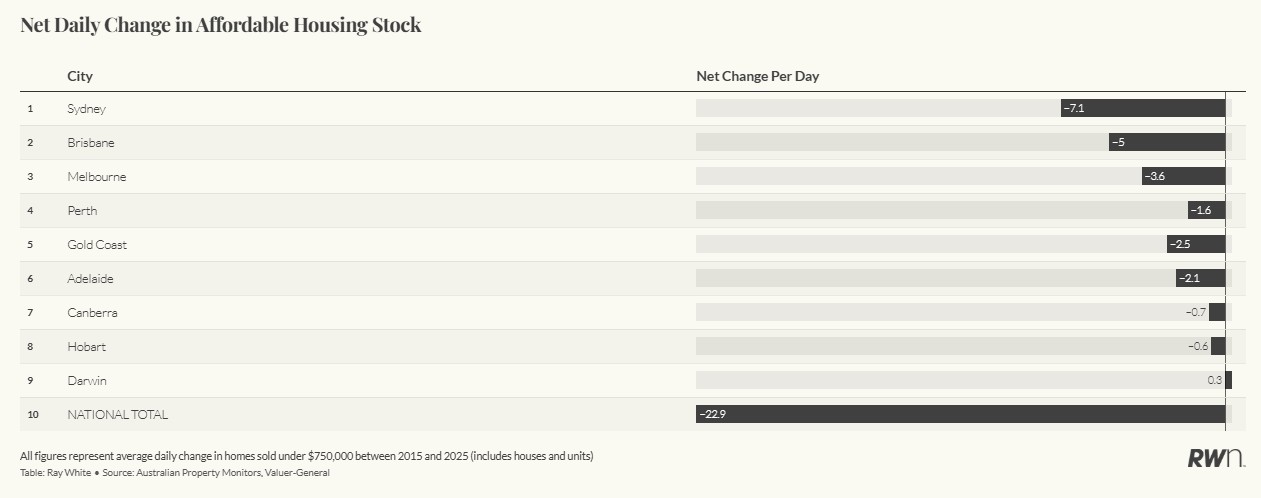Australian capital cities lose 24 affordable houses daily as Sydney leads decline with 7.1 properties vanishing per day. Despite unit growth, net loss reaches 23 affordable homes daily nationwide.
Australian capital cities are now collectively losing 24 affordable houses every single day. While the unit market is adding 1.5 affordable properties daily, this growth falls far short of offsetting house losses – creating a net reduction of nearly 23 affordable homes daily.
For this analysis, affordable was defined as being priced under $750,000. Analysis of all properties sold for under this price across Australia’s nine capital cities between 2015 and 2025 shows the net impact across all property types. Sydney leads the decline with 7.1 affordable properties disappearing daily, followed by Brisbane losing 5.0 and Melbourne 3.6. Even smaller markets show significant losses – Gold Coast sheds 2.5 properties daily, Adelaide 2.1, while Canberra and Hobart each lose around 0.7 properties per day. Darwin stands alone as the only capital showing growth, gaining 0.3 affordable properties daily.
Looking specifically at houses, Sydney loses 5.8 affordable houses daily – equivalent to one house vanishing from the affordable market every four hours. Brisbane follows closely at 5.5 houses per day, while Melbourne sheds 5.1 daily.
Between 2015 and 2025, Sydney’s affordable house stock collapsed from 24,009 to just 2,674 – an 89 per cent decline that mirrors similar trends across the Gold Coast (94 per cent decline) and Canberra (89 per cent decline). Perth loses 2.7 affordable houses daily, while Adelaide – traditionally an affordable capital – now sheds 2.2 houses per day from its sub-$750,000 market.
Even smaller markets aren’t immune. The Gold Coast loses 1.7 houses daily, Canberra 0.9, and Hobart 0.5. Only Darwin bucks the trend, actually gaining 0.2 affordable houses per day – making it the sole capital where buyers have better prospects today than a decade ago.
At current trajectories, Sydney’s mathematical path leads to zero affordable houses by 2027. While Brisbane and Melbourne retain larger affordable stocks, their rapid daily losses signal similar endpoint scenarios within the decade.
The crisis stems from multiple converging factors. Rising construction costs – which peaked at 17.8 per cent annually in 2022 – have pushed new housing in many cities beyond affordable thresholds. Chronic undersupply means demand continues outstripping available stock, while government first-home buyer assistance schemes paradoxically inflate prices by increasing buyer purchasing power without addressing supply constraints.
Ideally affordable units would be able to offset the reduction in affordable houses and the number of units priced under $750,000 has increased dramatically. Cities like Perth have seen 105 per cent growth in affordable unit sales, and Darwin recorded 71 per cent growth. Nationally, capitals are gaining just 1.5 affordable units per day.
The increase is clearly not enough to offset the drop in houses. Affordable unit gains compensate for only 6 per cent of affordable house losses, creating a net reduction of 22.9 affordable properties daily across all capitals. Even cities showing unit growth like Melbourne (+1.5 units daily) and Perth (+1.1 units daily) cannot match their house losses of 5.1 and 2.7 respectively. Australia is losing nearly 23 affordable homes daily with minimal replacement stock filling the void.
